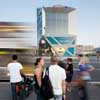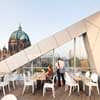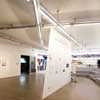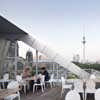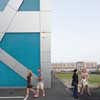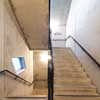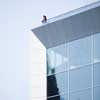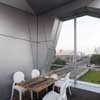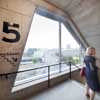Humboldt Box Berlin, Temporary German Building, Project, Photo, Design, Image
Humboldt Box, Germany : Temporary Berlin Building
Humboldt Box Building, Berlin, Germany design by KSV Krüger Schuberth Vandreike
Architecture Lightshow
Design: KSV Krüger Schuberth Vandreike
9 Oct 2011
Humboldt Box Berlin
Airbus lights up Berlin’s Humboldt-Box with its vision of the future of flight in 2050 Breathtaking lightshow launches Airbus Smarter Skies campaign ahead of ILA.
Humboldt Box Building, Berlin, Film on YouTube
A spectacular 4D projection light show transformed Berlin’s Humboldt-Box into a moving and pulsating canvas to demonstrate the benefits of smarter flight in the future. The show, which launches the Future by Airbus Smarter Skies vision of air travel in 2050 and beyond, illustrates in stunning perspective how smarter aircraft operations could cut travel times, reduce emissions and lead to fewer delays.
“Our light show unveils the significant benefits of combining smarter aircraft, smarter technology and smarter skies in 2050”, says Charles Champion, Executive Vice President Engineering at Airbus. “Our Smarter Skies vision is one where highly intelligent aircraft would be able to organise themselves and select the most efficient and environmentally friendly routes, making the best use of daily weather and atmospheric conditions. It is also one where aircraft might copy the best aspects of nature and fly like flocks of birds allowing them to travel more efficiently and lower their energy use.”
Beginning with a single paper aeroplane launched from the balcony of the Humboldt-Box, a maze of 3D blocks depicts the barriers and obstacles created by current national air space boundaries. A map of the world scattered with pin points and bright pulsing lines of light highlights the world’s busiest routes. The show then takes passengers forward in time to 2050 to demonstrate a world of flight where obstacles are removed, passenger travelling times are shortened, and where fuel use and emissions are reduced. The show closes with a fleet of Airbus concept planes flying in formation.
Charles Champion continues: “Our research for the Future by Airbus programme has shown that air passengers expect to fly more in the future, but they want to do so with fewer delays, less noise and more sustainably. The aviation industry has already committed to some of the toughest targets of any industry by pledging to cut aircraft emissions by 50% by 2050. Our Concept Plane has illustrated how aircraft design could contribute. Our Smarter Skies campaign, brought to life by this light display, demonstrates the future benefits that smart aircraft operations could bring if we work together as an industry to make them happen”.
The Future by Airbus Smarter Skies vision consists of five concepts which could be implemented across all stages of an aircraft’s operation. It includes aircraft launched into a continuous ‘eco-climb’, flying in formation using ‘express skyways’, ‘low noise’ glided approaches, low emission landing and ground operations and airports that grow their own alternative energy sources.
For more information on Future by Airbus go to www.thefuturebyairbus.com
Humboldt Box Berlin Lightshow information received 100912
Humboldt Box
“Transitory Architecture”
Design: KSV Krüger Schuberth Vandreike
This 27m high building seems very choking when integrated in the landscape, but it is only temporary, it will be dismantled when, in 8 years from now, its mission has been completed and when the Humboldt Forum is constructed. Holding exhibitions and events this building has also a store on the ground floor and a restaurant on the top.
Photos: Nelson Garrido
Project Description
The Humboldt Box will accompany the building of the Humboldt Forum/Stadtschloss Berlin as an information and exhibition structure. As a temporary building, it will be dismantled with the completion of the Humboldt Forum after a predicted lifetime eight years. Until then, later users of the Humboldt Forum – among them the National Museums in Berlin, the Prussian Cultural Heritage Foundation as well as the Central and Regional Library Berlin – will be using the structure to provide a glimpse into their various collections. The Association for the Rebuilding of the Berliner Stadtschloss will be informing visitors about the history of the Berlin Palace, the reconstruction of the palace façade, and the historical courtyard.
In this sense, the Humboldt Box is a communication structure that draws on familiar elements of temporary and technical construction, as commonly seen in scaffolding, stilt houses, tents or drilling platforms.
The transitory architecture will occupy a sensitive spot in the immediate vicinity of the Altes Museum, Lustgarten, and Berlin Cathedral, where the Unter den Linden avenue makes a slight turn into Spree Island. The view from the roof terrace offers an impression of the city’s size along with a surprisingly close relationship to the important places and buildings in Berlin’s historical Mitte district. With the start of construction for the underground railway and Humboldt Forum, the Humboldt Box will have to compete visually with the scaffolding and cranes that surround it.
The guidelines for the structure’s volume and purpose were described in detail in the competition announcement. The smallish building lot was tightly allocated to accommodate the larger site for the palace, and the majority of the lot was to be kept open to maintain easy access to pipeline routes. The diagonal sections traversing the allocated rectangular building area and the silhouette turn the box into a freestanding sculpture, mediating the kink in the street axis.
The above-ground supporting structure is a reaction to or reflection of these unique constraints: steel beams – vertical in the outer skeleton and horizontal at the ceiling-edge areas – are hung or slotted into the reinforced concrete floors and stairwells. The weight of the total of seven building levels is borne by four plinths located within the specified areas. This inevitably leads to high load concentrations that are carried by drilled shafts, whose depth (27 m) corresponds to the building height.
The distinctive structure of the steel skeleton results from optimised force distribution; it forms the framework for the changeable surface covering and has a high recognition factor. From its construction hoarding to its alterable cladding, “frame” and “perforation” are key elements with which the notion of the “temporary” can be staged and re-staged over the entire lifecycle of the Box.
The design and technical solution of employing the textile covering as an outer shell is based on the experience of the Megaposter company, and also points to the company’s expertise in implementing unusual, large-area billboard advertisements. Between the fabric and the building’s actual, porous concrete cladding is a 30 cm gap that is lit from behind. Swapping the textile covering or varying the colour of the light – to signal new exhibition content, for example – will allow changes in the Humboldt Box’s appearance over its lifetime of several years.
Cladding the interior ceilings and walls has been largely avoided. The robust surfaces are consistent with the temporary character of the building and enable the greatest possible flexibility in designing the different floors. Specified “shop windows” in the wall provide a view of the future construction site while large, panorama glazing opens the Humboldt Box to the north, in the direction of the Lustgarten. At night, this surface can be used as a media screen.
Located beneath the building – in between the Humboldt Box’s four plinths – is a weather-protected forecourt and waiting area for visitors. A large outdoor staircase or rather a gangway leads directly from the outside to the first floor, the heart of the Humboldt Box. Here we find the agora, a foyer framed with seating steps that serves as the starting point for visits to the exhibition areas.
The agora is also a good event location, a use that the designers encourage. The outdoor staircase on the ground floor begins with the agora (first floor) and continues as a visitors’ stairway for touring the exhibition levels on the second and third storeys, making it easy for viewers to find their way around. The tour ends on the third floor, in the reading lounge with a view of the Lustgarten and the Berlin Cathedral.
The fourth floor will be used for events. Moveable glass wall elements enable a variety of spatial situations. A café/restaurant is located on the fifth floor, including two panorama terraces: to the south overlooking the Humboldt Forum construction site and to the north, with a view of Unter den Linden that reaches all the way to the Brandenburg Gate, the Lustgarten and Alexanderplatz. If the glass elements in the façade are left completely open in good weather, the interior will flow directly over the two panorama terraces.
The Humboldt Box’s “transitory architecture” is a communicative, spatial sculpture: multi-purpose and designable levels on the inside – the final form of which is left up to the current occupant – and a sculpture with an alterable shell on the outside, born of the peculiarities of this little building lot and a precursor to the future, more sizeable Humboldt Forums construction site!
Berlin Architecture Walking Tours
Location: Humboldt Forum, Berlin
Berlin Architecture
Berlin Architecture Designs – chronological list
Nelson Garrido – external link to photographer’s website
Berlin Buildings – Selection
Jewish Museum building
Daniel Libeskind Architect
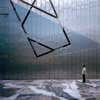
picture © Bitter Bredt
Jewish Museum Berlin
Federal Chancellery, Tiergarten
Axel Schultes & Charlotte Frank
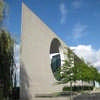
photo © Adrian Welch
Federal Chancellery Buildings
Hansaviertel Buildings
Design: various architects including Gropius, Niemeyer
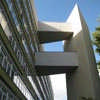
photo © Adrian Welch
Hansaviertel Buildings – Modern Berlin Architecture
Berlin Hauptbahnhof central station
Gerkan, Marg & Partners
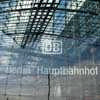
photo © Adrian Welch
Berlin Hauptbahnhof
Comments / photos for the Humboldt Box Berlin page welcome

